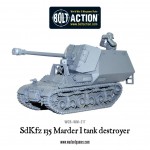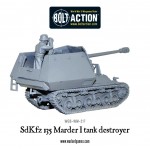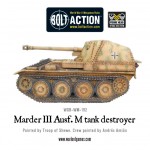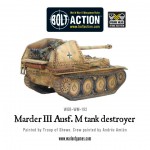The Marder was a series of German World War II tank destroyers built from 1942 to tackle the new Soviet KV1s and T-34s.
From the start of Operation Barbarossa in 1941, the need for a vehicle to take on the soviet tanks was apparent. The German army was fielding comparatively light tanks during this time and suffered considerably at the hands of the Soviet armour. They needed an anti-tank weapon that could be mobile and put into position quickly.
Rather than design a whole new tank to do so, the Germans took captured French vehicles such as the Lorraine, the Hotchkiss H39 and FCM 36 – as well as less effective Wehrmacht tanks such as the Panzer II and 38(t) and used them as the basis for makeshift tank destroyers by pairing them with captured Soviet 7.62 cm Pak 36(r) guns, or in later versions – the deadly Pak 40.
Marder I
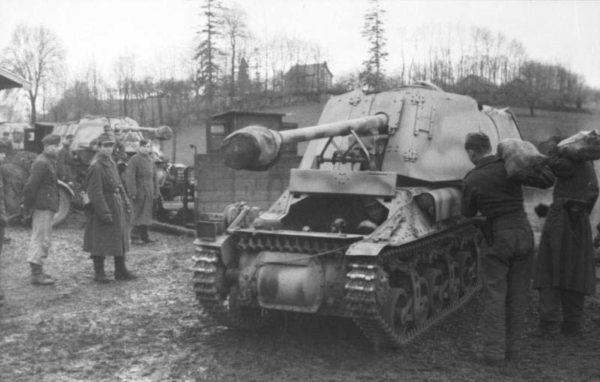
Though both the chassis and the armament varied – the most common Marder I design saw the French Lorraine Artillery Tractor (of which the Germans had captured more than 300 following the Fall of France in 1940,) paired with the deadly 7.5cm Pak 40.
The Lorraine was a relatively small chassis – so it was kept lightly armoured. The large gun was mounted atop the chassis within a thinly armoured gunshield which wrapped around the front and sides of the gun, and would provide limited protection against small arms fire and incoming shrapnel. The Marder was designed as a mobile platform for the anti-tank gun, and was not intended to go head-to-head with other tanks.
Marder II
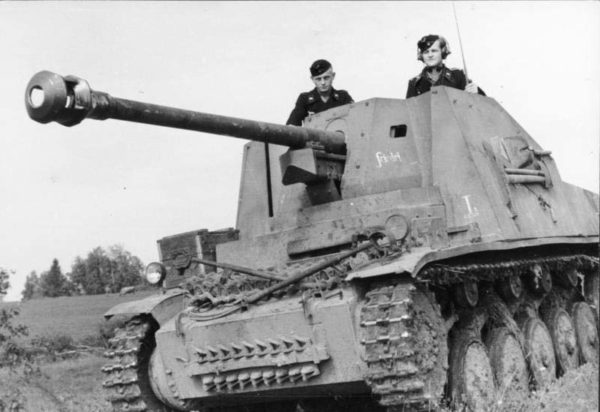
This vehicle was based on the Panzer II chassis and featured two versions. A modified Soviet 7.62cm gun was attached to one, due to many of these weapons being captured in the war with the Soviet Union. The high profile of this particular vehicle left it open to enemy fire, being easier to spot in a battlefield, and once more featured light armour for its crew. The second version of this vehicle was based on the Panzer II Ausf A-C series, as well as the Ausf F. These versions offered a widened compartment and used the 75mm PaK 40 anti-tank gun. The profile of the vehicle was also lowered, but still featured a crew compartment that was open on the top and to the rear. Featuring in panzer divisions of the Wehrmacht, Waffen-SS and even Luftwaffe units, these vehicles saw extensive action.
Marder III
This was to be an improvement in the series – the tank destroyer now featured either a Soviet 76.2mm F-22 Model 1936 divisional field gun (reconfigured to fire 75mm rounds) or a German 75mm PaK 40, mounted onto the chassis of a Czech Panzer 38(t). Produced from 1942-44 the vehicle fought on all fronts up until the end of the war. Still open-topped with nothing more than a canvas hood to protect the crew from harsh weather conditions, the crew were once again left vulnerable to enemy fire.
Marder III Ausf. H
The new variant featured the 75mm PaK 40 anti-tank gun mounted on a modified Panzer 38(t) Ausf H chassis. This vehicle featured the fighting compartment in the centre, allowing the crew to stay low and helped them against small arms fire and blast damage. It also featured a hull mounted Czech 7.92mm machine gun for added protection. About 275 were built in 1943.
Marder III Ausf. M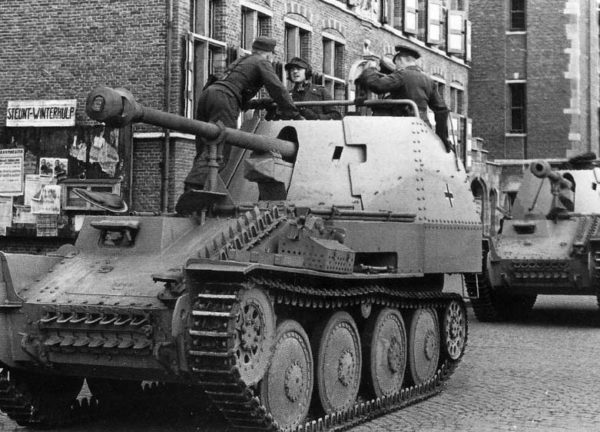
Built in 1943-44 the Ausf M was modelled on the chassis of a Panzerjager 38(t), with around 942 built. This version was the culmination of the Marder series and featured an improved fighting compartment with better protection for the crew, a lower profile to hide it from enemy fire and the engine was moved from the rear to the middle, enabling the crew to be situated in the bottom floor of the vehicle. The compartment was also closed off at the rear, giving the crew more protection, but reducing their visibility.
The machine gun was also swapped for a heavy calibre version, a MG34 or even a MG 42. Another key change was that the commander, who previously had to act as gunner was now free from doing so due to the relocation of the vehicle’s radio operator. This simple change increased the combat effectiveness of the tank destroyer.
Replacement
Production of the next wave of anti-tank vehicles had begun with the StuG III assault gun, which featured a fully armoured crew compartment. The armour on the Marder series was weak compared to the new tank hunter and the whole series was phased out of production with the arrival of the Jagdpanzer, but the Marder series would still be in service right up to the end of the war.
The Marder I and Marder III Ausf M are available as resin kits in the webstore, as well as a range of other tank destroyers:

